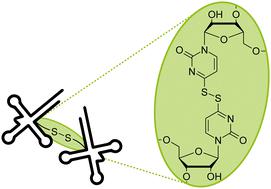当前位置:
X-MOL 学术
›
RSC Chem. Biol.
›
论文详情
Our official English website, www.x-mol.net, welcomes your feedback! (Note: you will need to create a separate account there.)
Reversible oxidative dimerization of 4-thiouridines in tRNA isolates
RSC Chemical Biology Pub Date : 2024-02-01 , DOI: 10.1039/d3cb00221g Larissa Bessler 1 , Jonathan Groß 2 , Christopher J. Kampf 2 , Till Opatz 2 , Mark Helm 1
RSC Chemical Biology Pub Date : 2024-02-01 , DOI: 10.1039/d3cb00221g Larissa Bessler 1 , Jonathan Groß 2 , Christopher J. Kampf 2 , Till Opatz 2 , Mark Helm 1
Affiliation

|
The occurrence of non-canonical nucleoside structures in RNA of biological or synthetic origin has encountered several recent boosts in attention, namely in the context of RNA modifications, and with an eye to RNA vaccines. New nucleoside structures introduce added functionality and function into biopolymers that are otherwise rather homogenous in their chemical structure. Here, we report the discovery of a presumed RNA modification that was identified by combination of liquid chromatography–tandem mass spectrometry (LC–MS/MS) with stable isotope labelling as a dimer of the known RNA modification 4-thiouridine (s4U). The disulfide-linked structure, which had previously been synthetically introduced into RNA, was here formed spontaneously in isolates of E. coli tRNA. Judicious application of stable isotope labelling suggested that this presumed new RNA modification was rather generated ex vivo by oxidation with ambient oxygen. These findings do not only underscore the need for caution in the discovery of new RNA modifications with respect to artifacts, but also raise awareness of an RNA vulnerability, especially to oxidative damage, during its transport or storage.
中文翻译:

tRNA 分离物中 4-硫尿苷的可逆氧化二聚化
生物或合成来源的 RNA 中非规范核苷结构的出现最近引起了一些关注,即在 RNA 修饰的背景下,以及着眼于 RNA 疫苗。新的核苷结构为生物聚合物引入了附加的功能和功能,而生物聚合物的化学结构是相当均匀的。在这里,我们报告了一种推测的 RNA 修饰的发现,通过液相色谱-串联质谱 (LC-MS/MS) 与稳定同位素标记相结合,将其鉴定为已知 RNA 修饰 4-硫尿苷 (s 4 U)的二聚体。先前已合成引入 RNA 的二硫键连接结构在大肠杆菌tRNA 分离株中自发形成。稳定同位素标记的明智应用表明,这种推测的新 RNA 修饰是通过环境氧的氧化离体产生的。这些发现不仅强调了在发现与人工制品相关的新 RNA 修饰时需要谨慎,而且还提高了人们对 RNA 脆弱性的认识,特别是在运输或储存过程中容易受到氧化损伤。
更新日期:2024-02-01
中文翻译:

tRNA 分离物中 4-硫尿苷的可逆氧化二聚化
生物或合成来源的 RNA 中非规范核苷结构的出现最近引起了一些关注,即在 RNA 修饰的背景下,以及着眼于 RNA 疫苗。新的核苷结构为生物聚合物引入了附加的功能和功能,而生物聚合物的化学结构是相当均匀的。在这里,我们报告了一种推测的 RNA 修饰的发现,通过液相色谱-串联质谱 (LC-MS/MS) 与稳定同位素标记相结合,将其鉴定为已知 RNA 修饰 4-硫尿苷 (s 4 U)的二聚体。先前已合成引入 RNA 的二硫键连接结构在大肠杆菌tRNA 分离株中自发形成。稳定同位素标记的明智应用表明,这种推测的新 RNA 修饰是通过环境氧的氧化离体产生的。这些发现不仅强调了在发现与人工制品相关的新 RNA 修饰时需要谨慎,而且还提高了人们对 RNA 脆弱性的认识,特别是在运输或储存过程中容易受到氧化损伤。



























 京公网安备 11010802027423号
京公网安备 11010802027423号